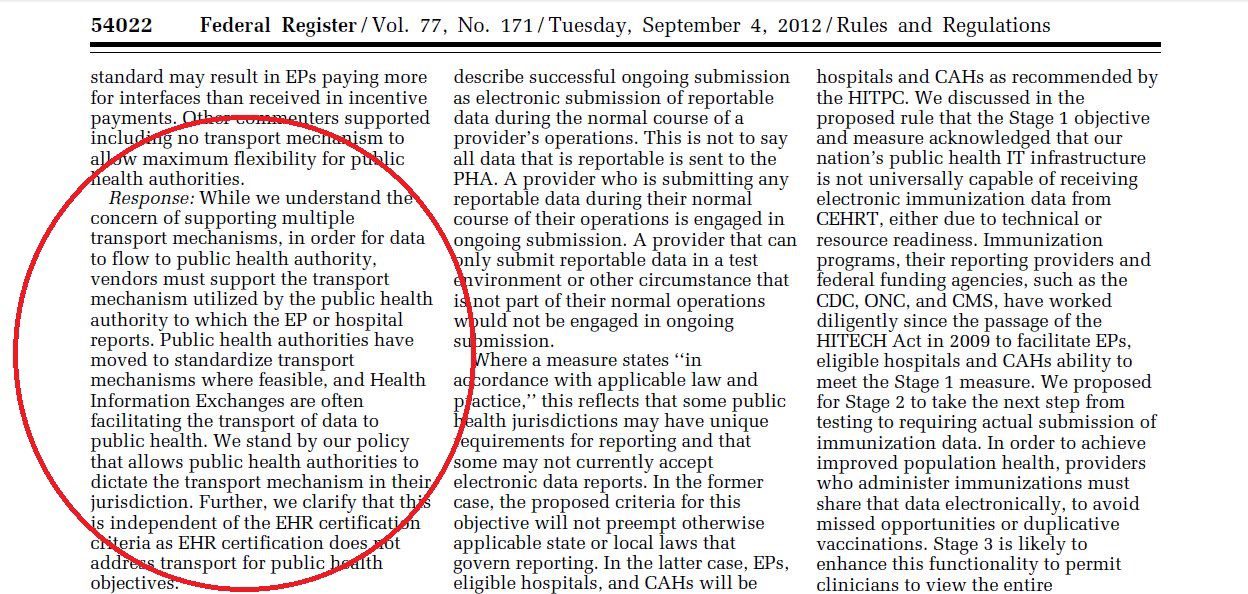Foundational Interoperability Standards Adopted by the ONC
In an article published in the New England Journal of Medicine in 2011, Dr. David Blumenthal, who was at that time head of the ONC, defined two conditions that were required to make health information exchange a reality:
1) technical interoperability, and 2) an economic, social, and political environment that fosters exchange. The first criterion, interoperability, was believed to be easier to achieve (Blumenthal, 2011). Leveraging HITECH, the ONC used discretionary funds to pay for development of standards that would be critical to creating a nationwide health information network. Considered a “down payment” towards interoperability, Blumenthal described an already developed and refined standard that was purported to be a “relatively simple form of exchange akin to email.” He also described an advanced bidirectional form of information exchange that was still a work in progress (Blumenthal, 2011). Both the email exchange (also known as directed exchange) and bidirectional exchange described by Blumenthal are classified as foundational interoperability standards. Despite public health reporting being a requirement for eligible hospitals and professionals participating in the EHR Incentive Program (CMS, 2010), the corresponding Standards and Certification Criteria Final Rule was silent with regards to transport standards that would be necessary for foundational interoperability with public health systems (ONC, 2010). In the absence of transport certification standards, the ONC, Centers for Disease Control and Prevention (CDC), and various stakeholders joined forces in 2011 to recommend transport standards for electronic submission to immunization registries. In total, five transport standards were evaluated. Work group members ultimately recommended the Simple Object Access Protocol (SOAP) as the best choice to meet the current and future data exchange needs, believing it had the best chance for broad adoption across disparate healthcare systems (CDC, 2012). In 2012, CMS and ONC coordinated the issuance of the Stage 2 Final Rule (CMS, 2012a) and 2014 EHR Certification Standards (ONC, 2012a). Both agencies remained steadfast in their position to exclude public health reporting transport standards from the regulations.

Figure 3: CMS Stage 2 Final Rule Narrative Regarding the Absence of Transport Standards
(CMS, 2012a)
The agencies did however specify that the Direct protocol for directed exchange was to be used for the Stage 2 Meaningful Use transitions of care objective (ONC, 2012b). Structural and Semantic Interoperability Standards Adopted by the ONC Standards for structural and semantic interoperability were detailed in the initial Standards and Certification Final Rule (ONC, 2010). Subsequent 2014 standards and certification criteria further narrowed the list of allowable standards that could be used by certified EHR technology (ONC, n.d. b). For example, Health Level Seven (HL7) messaging standard versions 2.3.1 and 2.5.1 were listed in the initial Standards and Certification Criteria Final Rule (ONC, 2010). For EHR vendors seeking ONC 2014 certification, the messaging standard was constrained to HL7 2.5.1 (ONC, 2012b). A second structural interoperability standard adopted for 2014 certification is the Consolidated Clinical Document Architecture (C-CDA) Continuity of Care Document (CCD), which is to be used for Stage 2 Meaningful Use transitions of care (ONC, 2012b). Examples of semantic interoperability standards specified for 2014 certification include RxNorm, Current Procedural Terminology (CPT), Logical Observation Identifiers Names and Codes (LOINC), and Systematized Nomenclature of Medicine-Clinical Terms (SNOMED CT) (ONC, 2012b).


